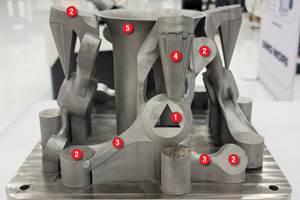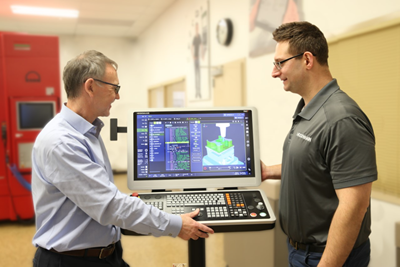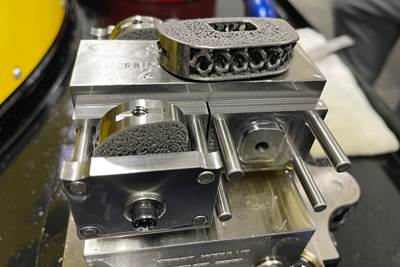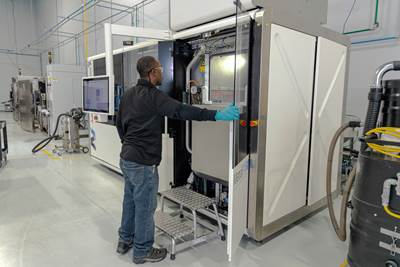Share



While searching for a realistic use case for additive manufacturing, the Siemens Industry team came across the steering knuckle in its eRods, which are essentially electric dune buggies. The original steering knuckles were designed for another vehicle, and were therefore ideal for optimization. Photos provided by Siemens Industry Inc.
Siemens’ Manufacturing in America event, held earlier this year in Detroit, served as a venue for manufacturers to share best practices and ideas, as well as highlight the company’s latest technologies. One thread that ran through the event was the digital thread, a framework that connects all stages of a part production process, from design to manufacturing to quality.
One presentation in particular illustrated the power of the digital thread. Zachary Gray, business development manager for additive manufacturing at Siemens Industry Inc., and Adam Hiller, additive manufacturing and Siemens Xcelerator portfolio solutions consultant at Siemens Digital Industries Software, walked attendees through the process of manufacturing a 3D printed steering knuckle from design to postprocessing, tracing the part’s movement along the digital thread.
Gray says Siemens is well-positioned to provide digital thread solutions. The company doesn’t make machine tools, but it supplies machine tool builders and therefore has the relationships to get the information needed to connect all stages of manufacturing.
Steering in the Right Direction
The project started as a way to show additive manufacturing’s potential as an industrial manufacturing solution. “We wanted a really interesting, great, eye-catching and realistic story for additive manufacturing,” Hiller says.
According to him, many of the parts 3D printing companies display at trade shows and other events, while striking and well-made, aren’t realistic use cases for additive manufacturing. For example, they might be too expensive or not fully optimized for process or performance.
“We said, ‘Let's make a part that is going to be something that would be made. An application that is going to optimize as much of that process as possible, and is going to give a really, really good part at the end, too, without it just looking cool, but actually being very good for the use case.’”
The team found this application in the steering knuckle of its Kyburz eRods (Hiller describes them as “electric dune buggies”). The original steering knuckles came from a 1995 Mazda, were made from cast iron and weighed just under 2.5 kilograms.
“They took it, they fit it on the car and they said it was good enough,” Hiller explains. “There were a lot of things that we noticed in regards to the strength and structural integrity that weren't needed.” In other words, it was the perfect candidate for optimization.
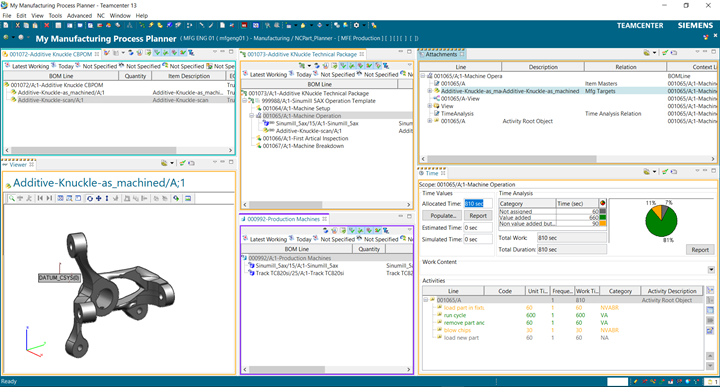
Siemens used its Teamcenter product lifecycle management (PLM) software to create documentation and connect programs downstream, enabling them to track the part as it went through scanning, design, optimization, printing, machining and inspection processes.
Design
The backbone of Siemens’ digital thread solution is Teamcenter product lifecycle management (PLM) software. This enables users to create documentation such as bills of engineering, bills of manufacturing, and bills of plant processes, as well as follow the steps a part goes through from scanning and printing to machining and quality. “That all gets tracked in this lifecycle management mindset,” Hiller explains. Essentially, PLM is where the “order” for the part originates.
The team scanned the original 1995 Mazda steering knuckle and imported it into Siemens NX along with the forces and loads on the part provided by Kyburz. Then they ran topology optimization on the part directly in NX. The goal was to reduce the part’s weight while increasing strength, maintaining safety and minimizing postprocessing (to ensure the model is additive friendly).
This may seem like a lot of factors to balance, but according to Hiller, “We’re kind of spoon-fed in a way, because the software does a lot of for you. It's a lot of plug and chug.” The real work comes in deciding what to do with all of the information the software puts out.
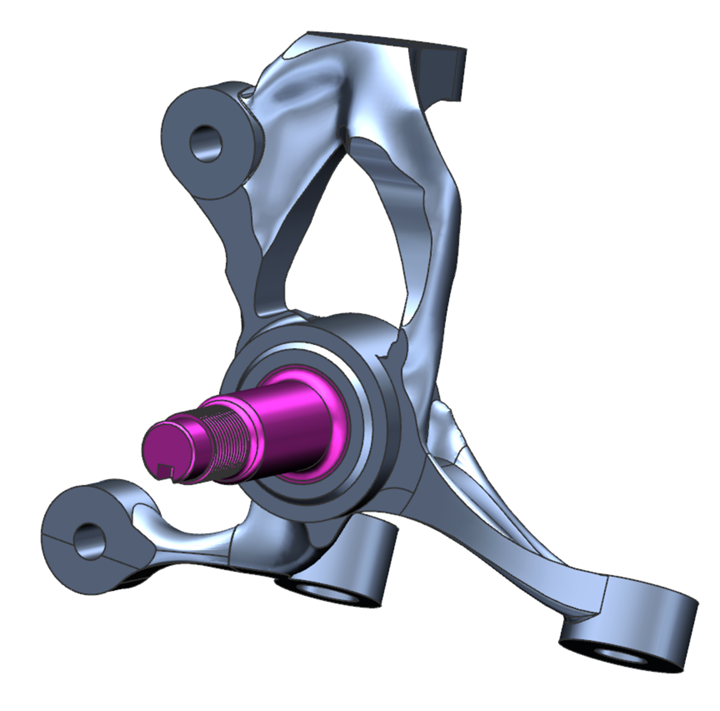
Starting with a scan of the original steering knuckle, the team used force and load data to optimize the part in NX with the goal of reducing weight while increasing strength, maintaining safety, ensuring 3D printability and minimizing postprocessing.
From here, Hiller made some manual changes, such as smoothing out the part to make it more aerodynamic, adding and removing material based on simulations and engineering concerns, and adding supports. This last point is particularly important to ensure that downstream processes such as machining can be performed as efficiently as possible. “We're thinking of the entire lifecycle now instead of just saying, the part looks cool, it does what we want and it will satisfy all our criteria,” he explains.
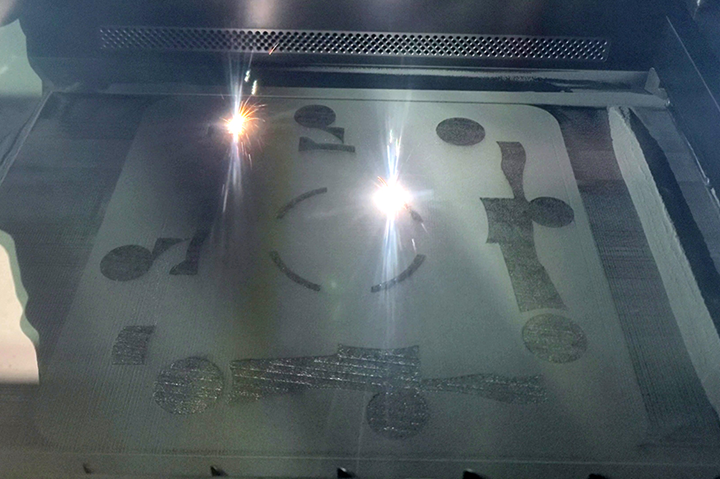
The team simulated the 3D printing process using a digital twin of the DMG MORI Lasertec machine used to print the part. Initial simulations showed warpage, which the team was able to correct so the part printed correctly the first time.
Simulation
Before the design was finalized, Hiller ran simulations of both the printing and machining processes to optimize manufacturability. Digital twins of both the part and the machine enable accurate simulations. “Having the digital twin of the product and a very solid platform that's connected allows you to do a lot of testing and reassurance before you even get the in-progress workpiece,” Gray says.
“We want that first-time-right manufacturing process so we know anything that might happen and can work around it in the software. That way, when we make the physical part, we know it will be correct,” Hiller adds.
The team used Simcenter to simulate the 3D printing process, in this case, selective laser melting (SLM) on a DMG MORI Lasertec machine. “We make sure that we can simulate every single part of the process from laser wattage to the type of powder that you're using, the printer that you're using, to make sure that we are as accurate as possible when going through the printing process,” Hiller explains.
Simulation can expose potential issues with wall thickness, trapped supports, channel ratio issues and voids. Simulation is also particularly important for powder bed processes such as SLM because parts are susceptible to warpage due to the heat of the laser melting process. “It's going to happen. It's just the way that physics works,” Hiller adds. “So we need to make sure that we can figure out how exactly that's going to happen.” The simulation showed warpage near the top of the part, so Hiller created compensatory geometry to counteract it. “We kind of fool the model into printing correctly,” he explains.

The team simulated the machining process of the steering knuckles, which showed that vibrations were likely to rip the parts off the build plate. Designers and machinists worked together to re-orient the parts and create a trumpet-shaped mounting structure in the middle of the build plate.
Next, the team used NX for build preparation, adding supports and programming the machining process. They then simulated the machining process to check for potential problems that could be solved with design changes. For example, they added a triangle-shaped feature in the center of the spindle hole to mount the part, and later mill it out.
The machining simulation also led to major changes in how the part was mounted on the build plate. The machinists noticed in the simulation that the vibrations in the machining process were likely to rip the parts off the build plate. They suggested Hiller re-orient the parts and mount them to a structure in the center of the build plate.
Hiller and the machinists collaborated to design a solution, which they called the “trumpet.” “That was something very interesting that I would have never thought of doing, but because we were collaborating a lot on it, we came up with this crazy design,” Hiller notes.
Hiller says the digital thread made collaboration between the designers and the machinists seamless. Manufacturing often requires collaboration between different teams, and this is especially true for AM, as the steering knuckle shows. Even for small errors, such as forgetting to remove a bolt hole, “in a typical environment, a lot of that is not as easily traced back,” Hiller explains.
If the PLM, CAD, CAM and the AM build prep software are all separate, that change needs to be made in all of those programs separately. With a digital thread, the change only needs to be made once, and the file gets updated everywhere.
Industrializing AM
Once the design and manufacturing processes were finalized, the team used Opcenter manufacturing operations management software to track the parts as they went through the manufacturing process. The final part, made from Ti-64, weighs just over 1 kilogram. This represents a 45% weight reduction, while strength was increased by 150%.
The 3D printed part costs more ($2,000 vs. $200 for the original), but for the application, volume and improved performance, Hiller says this isn’t totally unrealistic. The process also required no tooling and, with first-time right printing, didn’t require multiple physical iterations.
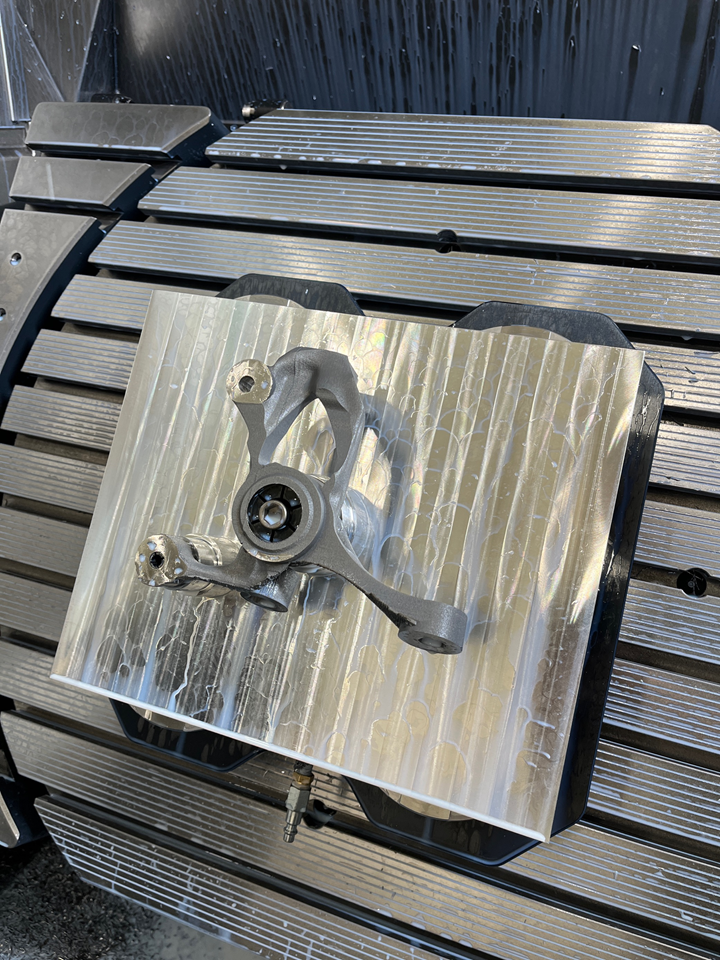
The final 3D printed steering knuckle was made from Ti-64 and weighs just over 1 kilogram, compared to the original cast iron steering knuckle, which weighed just under 2.5 kilograms. In addition to being 45% lighter, the 3D printed version is 150% stronger.
According to Hiller and Gray, the digital thread does more than enable first-time right manufacturing — it could help industrialize 3D printing. Manufacturing requires a lot of steps, and this is especially true for additive. Processes also get more complex as manufacturing scales up and more machines and parts are involved. Having too many disconnected parts creates a barrier to fully industrialized AM.
Implementing a digital thread is easy for additive because it’s an inherently digital technology, but machining can also benefit from the optimization and collaboration enabled by the digital thread. Machined parts can go through design changes, just like the steering knuckle. “Even if you take away additive from the storyline that we’re talking about, the digital thread is a wonderful tool for traditional manufacturing and CNC users,” Gray points out.
Related Content
Designing a 3D Printed Part with Machining in Mind
Designing extra stock and mounting features into a 3D printed part can aid in machining processes downstream.
Read MoreHow to Meet Aerospace’s Material Challenges and More at IMTS
Succeeding in aerospace manufacturing requires high-performing processes paired with high-performance machine tools. IMTS can help you find both.
Read MoreOEMs Showcase Hybrid Manufacturing Applications
Mazak and Mastercam worked together to demonstrate the viability of hybrid additive/subtractive machining techniques at a recent event held in Florence, Kentucky.
Read MoreMachine Tool Drawbar Made With Additive Manufacturing Saves DMG MORI 90% Lead Time and 67% CO2 Emission
A new production process for the multimetal drawbar replaces an outsourced plating step with directed energy deposition, performing this DED along with roughing, finishing and grinding on a single machine.
Read MoreRead Next
Generating a Digital Twin in the CNC
New control technology captures critical data about a machining process and uses it to create a 3D graphical representation of the finished workpiece. This new type of digital twin helps relate machining results to machine performance, leading to better decisions on the shop floor.
Read MoreAn Additive Manufacturing Machine Shop
Finish machining additively manufactured implants requires different pacing and workflow than cutting parts from stock — different enough for an experienced manufacturer to warrant a dedicated machine shop.
Read MoreThe Benefits of Vertically Integrating Metal 3D Printing and Machining
Having 3D printing and machining within one organization enables Addman’s engineers to collaborate and consolidate so it can quickly make successful metal 3D printed parts.
Read More























